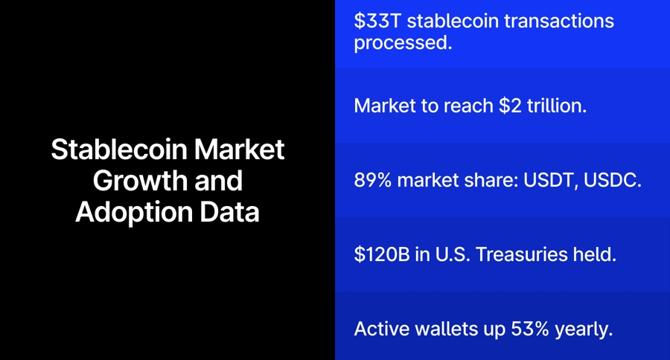Financemagnates
3w
306

Image Credit: Financemagnates
Stablecoins Take Off in 2025 as PayPal, Stripe, and Washington Back the Push
- Stablecoins are gaining momentum in 2025 with Stripe acquiring Bridge and PayPal integrating PYUSD for merchant payments, signaling a pivotal year.
- Stablecoin transactions exceeded $33 trillion last year, surpassing Visa and Mastercard networks, leading analysts and institutions to view stablecoins as essential to the financial system.
- Standard Chartered predicts the stablecoin market could grow to $2 trillion by 2028 from the current $230 billion.
- Stablecoins are proving valuable for global transactions, offering fast, low-cost cross-border payments, with the potential to transform financial inclusion for unbanked populations.
- Tether's USDT and Circle's USDC currently dominate the market with an 89% share, but new entrants like EURC and XCHF tied to the euro and Swiss franc are diversifying the market.
- Regulatory momentum in the U.S. suggests the possibility of stablecoin legislation under the next administration, with institutions and governments likely to join the stablecoin ecosystem.
- Major banks are considering issuing their own stablecoins, with Bank of America showing interest pending legal clarity, while bipartisan discussions in Washington hint at forthcoming legislation.
- Stablecoin issuers have become significant buyers of U.S. Treasury notes, holding over $120 billion in 2024, reinforcing global demand for the U.S. dollar and strengthening the U.S. debt markets and dollar dominance.
- User adoption of stablecoins is rising, with active stablecoin wallets increasing by 53% this year, and monthly transfer volumes doubling year-over-year in February to reach $4.1 trillion.
- Stablecoins are bridging traditional finance and the decentralized economy, offering stability in contrast to volatile cryptocurrencies and becoming a crucial layer in global finance.
- The article emphasizes that 2025 is a pivotal year for stablecoins to become a central player in digital money, with growing user engagement, regulatory developments, and major players entering the market.
Read Full Article
18 Likes
For uninterrupted reading, download the app